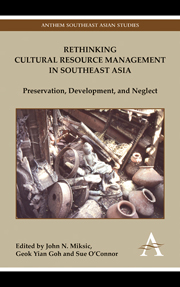Book contents
Chapter 2 - Wrecked Twice: Shipwrecks as a Cultural Resource in Southeast Asia
from Southeast Asia (General)
Published online by Cambridge University Press: 05 May 2012
Summary
Introduction
There are thousands of instances of ships being lost throughout Southeast Asia over the centuries. Over a hundred have been found. Dozens make an appearance in various maritime museums. Only a handful of ships have been the subject of comprehensive study and display. It is indeed regrettable that such a tiny fraction of the maritime cultural resource has actually made it to a worthy finale. Incredible amounts of information have been irretrievably lost through looting, dynamite fishing, trawling, and irresponsible legal salvage. The ships have, in effect, been wrecked twice. However, there are still unspoiled wrecks out there, awaiting proper excavation, documentation, study and display. If only the awareness, knowledge, enthusiasm and political will could be brought to bear.
Every country in Asia has a different policy on how to deal with the discovery and excavation of ancient shipwrecks. Some allow commercial involvement, while others strictly forbid it. Some are proactive while others are reactive. Some are effective in recording and preserving this nonrenewable cultural resource while others are not. Yet, none of the policies is “ideal.” The author has carried out shipwreck survey and excavation work in four Asian countries and remains informed on activities in several others. This chapter outlines various national policies and highlights their achievements and failings to the societies they supposedly serve, rather than to institutions or salvors.
Here, commercial involvement refers specifically to the sale of artifacts recovered from shipwreck sites with the intent to cover costs or to make a profit.
- Type
- Chapter
- Information
- Rethinking Cultural Resource Management in Southeast AsiaPreservation, Development, and Neglect, pp. 15 - 36Publisher: Anthem PressPrint publication year: 2011
- 2
- Cited by



